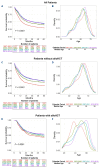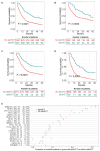Outcomes with intensive treatment for acute myeloid leukemia: an analysis of two decades of data from the HARMONY Alliance
- PMID: 39506894
- PMCID: PMC12050940
- DOI: 10.3324/haematol.2024.285805
Outcomes with intensive treatment for acute myeloid leukemia: an analysis of two decades of data from the HARMONY Alliance
Abstract
Since 2017, targeted therapies combined with conventional intensive chemotherapy have started to improve outcomes of patients with acute myeloid leukemia (AML). However, even before these innovations, outcomes with intensive chemotherapy had improved, which has not yet been extensively studied. Thus, we used a large pan-European multicenter dataset of the HARMONY Alliance to evaluate treatment-time dependent outcomes over two decades. In 5,359 AML patients, we compared the impact of intensive induction therapy on outcome over four consecutive 5-year calendar periods from 1997 to 2016. During that time, the 5-year survival of AML patients improved significantly, also across different genetic risk groups. In particular, the 60-day mortality rate dropped from 13.0% to 4.7% over time. The independent effect of calendar periods on outcome was confirmed in multivariate models. Improvements were documented both for patients <60 and ≥60 years old, and in those treated with and without consolidating allogeneic hematopoietic stem cell transplantation (alloHCT). While survival of AML elderly patients remains poor, patients ≥60 years old overall have a 20% survival benefit at 5 years if they receive an alloHCT. While further outcome improvement in intensively treated AML patients will likely be driven by targeted treatment approaches, this pan-European HARMONY dataset can serve as a multicenter comparator for future studies.
Figures






References
-
- Yates JW, Wallace HJ, Ellison RR, Holland JF. Cytosine arabinoside (NSC-63878) and daunorubicin (NSC-83142) therapy in acute nonlymphocytic leukemia. Cancer Chemother Rep. 1973;57(4):485-488. - PubMed
-
- Mayer RJ, Davis RB, Schiffer CA, et al. . Intensive postremission chemotherapy in adults with acute myeloid leukemia. Cancer and Leukemia Group B. N Engl J Med. 1994;331(14):896-903. - PubMed
-
- Cornelissen JJ, Gratwohl A, Schlenk RF, et al. . The European LeukemiaNet AML Working Party consensus statement on allogeneic HSCT for patients with AML in remission: an integrated-risk adapted approach. Nat Rev Clin Oncol. 2012;9(10):579-590. - PubMed
-
- Döhner H, Estey EH, Amadori S, et al. . Diagnosis and management of acute myeloid leukemia in adults: recommendations from an international expert panel, on behalf of the European LeukemiaNet. Blood. 2010;115(3):453-474. - PubMed
Publication types
MeSH terms
LinkOut - more resources
Full Text Sources
Medical

